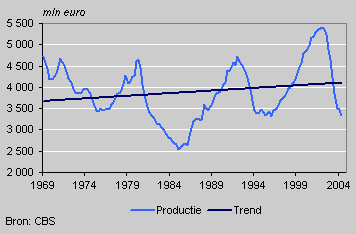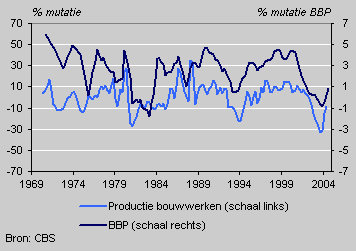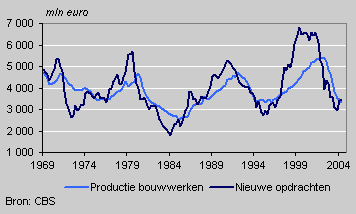Utility construction: recovery on the horizon

New construction of utility buildings is in passing through a rough patch at the moment: production is 38 percent down on 2001. Such sharp drops have not been uncommon in the last 35 years, though.
Construction output

Construction output fluctuates strongly
The trend in the completion of new utility buildings shows an increase of 0.3 percent on average over the last 35 years.
The actual production fluctuates strongly. Cycles of around ten years can be distinguished in the production of buildings, with on average five years between a peak and a trough.
Peak years in the construction of utility buildings were 1981, 1992 and 2002, low points were in 1975, 1985 and 1995. the fall between 1980 and 1985 was relatively very large at 46 percent.
Just over two years after the peak in 2001 the production of new utility construction had fallen by nearly 40 percent.
Production of utility buildings and economic growth

Rise and fall
The increase in utility construction output coincides with economic growth (GDP volume change). Generally speaking, the production of buildings rises as economic growth increases, and decreases as economic growth slows down or becomes negative. The latter was the case in 1982 and 2003. The production of new buildings fell strongly in these periods. Production also decreased when GDP growth slowed down in 1993.
Production of buildings and new commissions

Architects’ bureaus predict growth and decreases
Developments in net received commissions of architects’ bureaux are a good indicators of increase or decrease in construction output.
The number of new commissions received is a precursor of production. Figures also show that the number of new commissions for architects fluctuates even more than the production of new utility buildings.
The slight rise in the number of new commissions of architects’ bureaux since the beginning of 2004 can be seen as an indication that the production of utility construction is set to recover.
Kees Roeleveld and Marius Reitsema